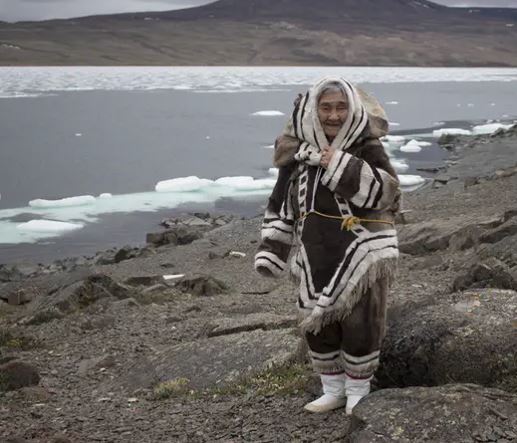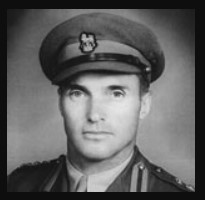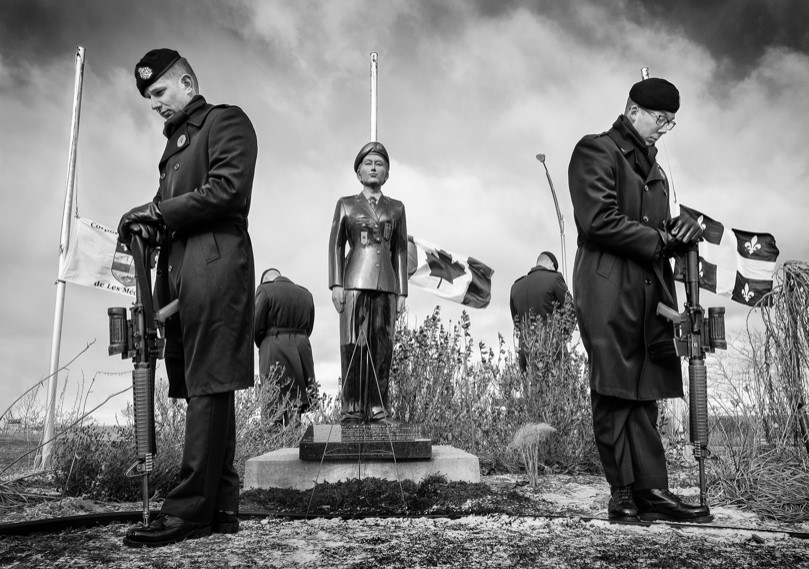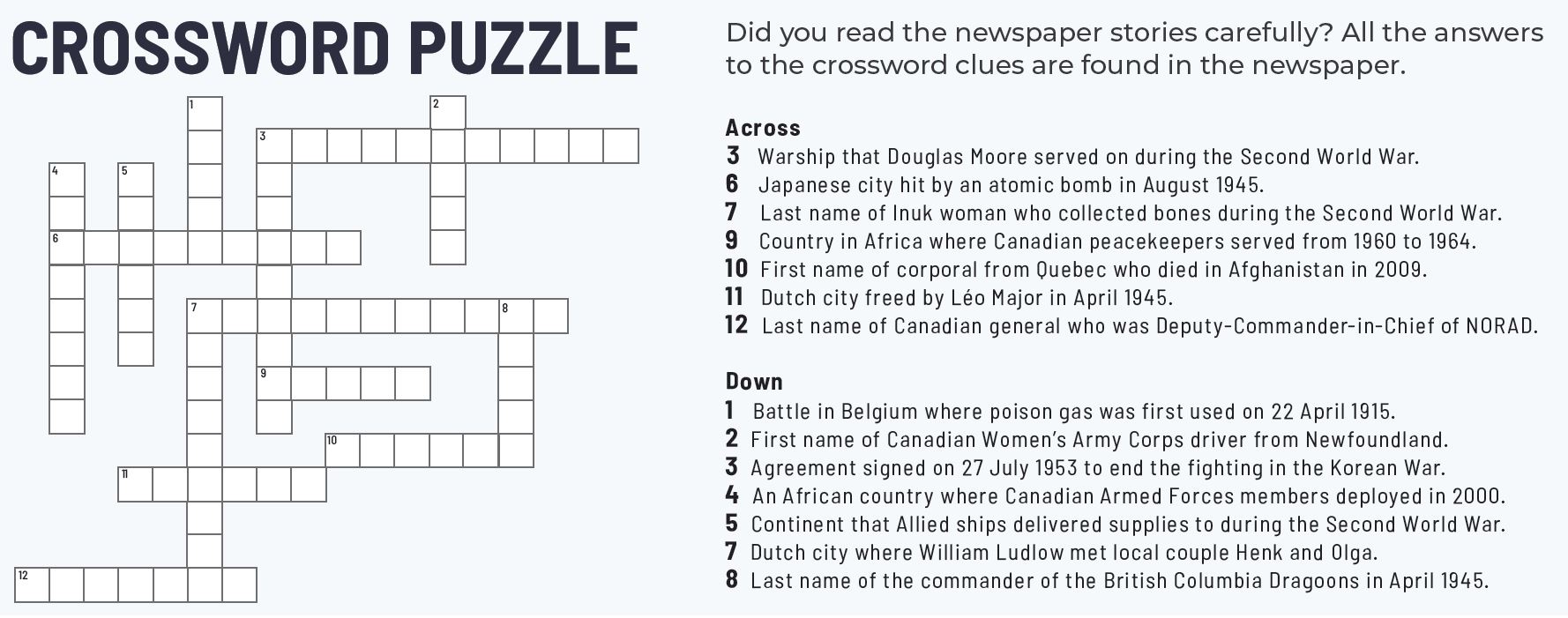Canada Remembers Times
Veterans’ Week Special Edition
5-11 November 2020 - Page 4
Bag of bones
Inuk Elder Qapik Attagutsiak.
Photo: Parks Canada
The Second World War was fought on many fronts, including technological innovation. Scientists came up with many important developments to help give the Allies an advantage in the struggle. Canadians on the home front were even encouraged to salvage bones from food scraps to be processed into useful war materials.
One such Canadian was Qapik Attagutsiak, an Inuk woman from the territory now known as Nunavut. In late May 1940, the 20-year-old Qapik picked up a burlap bag, put her one-year-old son in her amauti (a caribou skin parka with a built-in baby pouch) and got to work. The young mom went out to the walrus and seal harvesting grounds to fill her sack with bones—a task she would continue doing throughout the war. The bones were shipped to cities like Montréal and Halifax where they were processed to make fertilizer, ammunition or glue for aircraft.
After the war she was a seamstress and midwife, delivering many babies. Qapik, now 100 years of age, is the last known living person from the Arctic to have participated in the bone collection effort. The Inuk elder was honoured in 2020 by Parks Canada as a Hometown Hero—joining more than 140 Canadians who have been specially recognized for their efforts during the First or Second World War.
A long tradition of care
A Canadian Armed Forces Nursing Officer helping a child in El Salvador in 2013.
Photo: Public domain
The year 2020 has been designated the “Year of the Nurse and the Midwife” by the World Health Organization to recognize the dedication of those who have worked in these vital professions.
Thousands of nurses have served in Canada’s military over the years. In the First World War, Nursing Sisters often served close to the front lines, on hospital ships, as well as in hospitals overseas and in Canada. These nurses were nicknamed the “bluebirds” because of their striking blue dresses and white veils.
Canadian Nursing Sisters served again in the Second World War and in Korea, helping care for the sick and wounded. Known as Nursing Officers today, these health professionals help take care of Canadian Armed Forces members, at home and abroad. When serving in peace support missions overseas, Nursing Officers often face the same hazards and conditions as many other troops. Their long tradition of professionalism and care is still going strong. Thank you for all you do, Nursing Officers!
The dangers of peacekeeping
Brigadier Harry Angle.
Submitted photo
Being a member of the military often means putting your life on the line, even if it’s not in the middle of a war zone. Hundreds of thousands of Canadians have served since the Korean War and sadly, more than 1,800 have died in the course of duty. Brigadier Harry Herbert Angle was one of them.
Angle was born in 1906 in England and moved to Canada at 16 to work on fruit farms in the Okanagan Valley of British Columbia. He enlisted in the Canadian Army in 1939, shortly after the outbreak of the Second World War. He rose through the ranks to command the British Columbia Dragoons by the end of the conflict, fighting in Italy and Northwest Europe. His bravery was recognized in April 1945, when he was awarded the Distinguished Service Order.
Angle continued his impressive military career after the war. Tragically, he died in a plane crash on 17 July 1950, while serving as Chief Military Observer in Kashmir with the United Nations Military Observer Group in India and Pakistan. He was the first Canadian to lose his life while serving in a United Nations mission. He was laid to rest in the York Road Cemetery in New Delhi, India—the only Canadian serviceman buried there.
Did you know?
Explore our “Remembrance dog tags – Canadians buried alone” activity to learn more about fallen soldiers like Brigadier Angle.
Honouring corporal Karine Blais
A remembrance ceremony in Les Méchins, Quebec in November 2019.
Photo: Courtesy of Stéphane Picard collectif135.com
Karine Blais grew up in Les Méchins, Quebec. She joined the military at age 18 and was deployed to Afghanistan with the 12e Régiment blindé du Canada in 2009. The dangers of serving in a war zone are constant. Only two weeks after her arrival, the vehicle she was travelling in hit a roadside bomb near Kandahar on April 13, killing the 21-year-old woman and wounding four more soldiers. Her death was a huge loss to her family, comrades and friends, and a brutal reminder that life is fragile.
The community, supported by her former regiment, decided to pay tribute to Corporal Blais. They erected a statue of her along the picturesque St. Lawrence River. The statue is in a small roadside park and includes flags, two benches and a memorial plaque. More than 10 years have passed since her tragic death, but her memory lives on.
History in your pocket
Image: Royal Canadian Mint
The next time you are buying a snack, have a close look at the money you may be using. The Royal Canadian Mint has created a number of special 2020 coins that commemorate the 75th anniversary of the end of the Second World War. Some of them are collector editions that must be ordered but an eye-catching $2 coin was widely released in September. Its design features “V for Victory”—a famous slogan and symbol that helped keep hope alive in Britain, Canada and other Allied countries during the dark days of the Second World War. So keep your eyes open for some cool history in your pocket and remember those who did so much to allow us to live in peace today!
A lifetime of service and gratitude
Lieutenant-General Louis Cuppens (Retired).
Photo: Last Post Fund
Louis Cuppens was born in 1943 in Nijmegen, Netherlands, during the harsh German occupation in the Second World War. His family, like so many others, suffered from persecution and starvation. Over 175,000 Canadians took part in the Liberation of the Netherlands. The efforts of our troops were greatly appreciated by the Dutch people and the Cuppens family decided to immigrate to Canada and build a new life.
Settling in New Brunswick in 1950, the family never forgot the sacrifices of Canadian soldiers. Louis’ father, Frans, joined the Royal Canadian Legion because he wanted to support Veterans. Louis decided to join the Canadian military in 1960 as his own way to show his appreciation. He had a long and distinguished career in uniform, retiring in 1998 as Deputy-Commander-in-Chief of the North American Aerospace Defense Command (NORAD).
His service to Canada did not end, however, as Lieutenant-General Cuppens (Retired) went on to be the National President of the Last Post Fund and serve on the board of the Canadian Corps of Commissionaires, among other commitments.
Appreciating living in “the land of the free,” he remains a strong advocate for Veterans—his way of supporting a new generation of service members.
Crossword puzzle
Did you read the newspaper stories carefully? All the answers to the crossword clues are found in the newspaper.
Across
3 Warship that Douglas Moore served on during the Second World War.
6 Japanese city hit by an atomic bomb in August 1945.
7 Last name of Inuk woman who collected bones during the Second World War.
9 Country in Africa where Canadian peacekeepers served from 1960 to 1964.
10 First name of corporal from Quebec who died in Afghanistan in 2009.
11 Dutch city freed by Léo Major in April 1945.
12 Last name of Canadian general who was Deputy-Commander-in-Chief of NORAD.
Down
1 Battle in Belgium where poison gas was first used on 22 April 1915.
2 First name of Canadian Women’s Army Corps driver from Newfoundland.
3 Agreement signed on 27 July 1953 to end the fighting in the Korean War.
4 An African country where Canadian Armed Forces members deployed in 2000.
5 Continent that Allied ships delivered supplies to during the Second World War.
7 Dutch city where William Ludlow met local couple Henk and Olga.
8 Last name of the commander of the British Columbia Dragoons in April 1945.
- Date modified:






